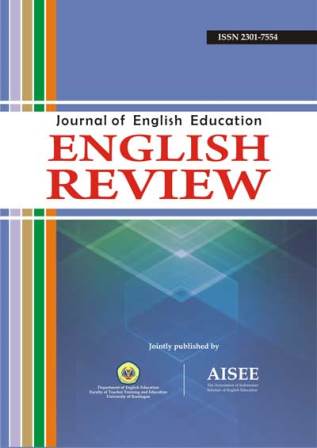SYMBOLIC AND PROPHETIC SYNTAGMAS IN CHINUA ACHEBE’S ANTHILLS OF THE SAVANNAH
Abstract
This essay discusses Achebe’s delineation of characters, events and use of language in Anthills of the Savannah (AS) as symbolic and prophetic syntagmas which later manifested in some real life personalities and socio-political phenomena in Africa and Nigeria, the setting of the novel. The primary source of data is Anthills of the Savannah. Secondary source and the internet were also consulted for the theoretical background and literature review. Grammatical structures and literary features were extracted and analyzed to show their associative and symbolic links with real life events which occurred after 1987, the year AS was published. The symbolic and prophetic syntagmas identified and their manifestations are presented with annotations in tables. The essay established that Achebe uses syntagmas of utterances, events, settings and characters to symbolize and foreshadow imminent events in the novel and socio-political occurrences in Nigeria and Africa, a feat which stands him out as a novelist with great prophetic insight and clairvoyance.
Keywords: Achebe, AS, syntagma, prophetic, symbolic. characterReferences
Abrams, M.H, & Harpham, G.G. (2009). A glossary of literary terms. 9th ed. Boston: Wadsworth.
Achebe, C. (1987). Anthills of the savannah. Ibadan: Heinemann.
Achebe, C. (1966). A man of the people. London: Heinemann.
Ademosun, F. (2013). Festus Iyayi: Assassination or Accident?. Sahara Reporters: News and Reports. 3 Nov. 2013. Retrieved from the Web. 13 Mar. 2014.
Chandler, D. (2007). Semiotics for beginners. Retrieved from http://www.aber.ac.uk/media/documents/54B/semiotic.htm. 13 Feb. 2013.
Crystal, D. 2009. A Dictionary of linguistics and phonetics. Oxford: Blackwell.
Ebhosele, E. (2013). Outrage over killing of Festus Iyayi by police escort truck in Kogi governor’s convoy. Retrieved from Sahara Reporters. 13 Mar. 2014.
Echeruo, M.J.C. (1998). Chinua Achebe’s Anthills of the Savannah: Post-history and biblical example. Theoria: A Journal of Social and Political Theory. 91, 66-86.
Ekundayo, S. B. (2002). Total literature in English (2nd ed). Benin: Nobel Publishers.
Ekundayo, S.B., & Iyayi, F. (2013). The place of literature in individual and national development. Journal of the Literary Society of Nigeria (JLSN).5, 83-93.
Miles, A. (2000). Hypertext syntagmas: Cinematic narration with links. Journal of Digital Information 1.7, 1-2.
Ngara, E. (1990). The place and significance of Anthills of the Savannah, pp. 247-263. In Edith Ihekweazu Ed. Eagle on Iroko: Selected papers from the Chinua Achebe International Symposium 1990. Ibadan: Johnmof.
Ogiovoh, E. E. (2005). Multiple points of view and the fight against oppression in Achebe’s Anthills of the Savannah. Long Essay. University of Benin,
Ojinmah, U. (1991). Chinua Achebe: New perspectives. Ibadan: Spectrum.
Okafor, K. (1990). The Quest for social change: Reformation or revolution. Eagle on Iroko: Selected Papers from Chinua Achebe International Symposium 1990. Ed. Edith Ihekweazu. Ibadan: Johnmof.
Owomoyela, O. (2002). Discourse on gender: Historical contingency and ethics of intellectual work. West African Review, 1-12.
Reuters. (2009). Ken Saro-Wiwa. The New York Times. Capital one 360. Retrieved from the Web March, 2013.
Richards, J.C., Platt, J., & Platt, H. (1992). Longman dictionary of language teaching and applied linguistics. London: Longman.
Saussure, de F. (966). A course in general linguistics. Trans. Wade Baskin. New York: McGraw Hill.
Silvers, A. (1991). The story of art is the test of time. The Journal of Aesthetics and Art Criticism 49(3),211-224.
USA Today. 2007- 2013. Product description. Amazonfresh. Retrieved from the Web. 4 Feb. 2015.
Umukoro, S.O. (2009). Literary criticism, scholarship and national development. 18th Inaugural lecture of the Delta State University. Abraka: Delta State University Press.
Wikipedia: Ken Saro-Wiwa. Retrieved from <http://en.m.wikepedia.org/wiki/kensarowiwa>12 March, 2015.
Wikepedia: Ellen Johnson Sirleaf. Retrieved from Wikepedia <http://en.m.wikepedia.org/wiki/Ellen_johnson_sirleaf>12 Mar. 2015.
All articles published in English Review: Journal of English Education (ERJEE) are licensed under the Creative Commons Attribution 4.0 International License (CC BY 4.0).
Copyright Ownership
Authors retain the copyright of their articles and grant ERJEE the right of first publication. The journal is granted a non-exclusive license to publish, reproduce, and distribute the article in any format, medium, or platform, provided that proper credit is given to the original authors.
License Terms – CC BY 4.0
Under the Creative Commons Attribution 4.0 International License, others are free to:
- Share — copy and redistribute the material in any medium or format
- Adapt — remix, transform, and build upon the material for any purpose, even commercially
As long as they:
- Provide appropriate credit to the original author(s) and source
- Provide a link to the license (https://creativecommons.org/licenses/by/4.0/)
- Indicate if any changes were made
There are no restrictions on the reuse, reproduction, or adaptation of published articles as long as attribution is properly given.
Author Warranties
By submitting a manuscript to ERJEE, authors confirm that:
- The work is original and does not infringe any existing copyright.
- The manuscript has not been previously published and is not under consideration elsewhere.
- All sources and references are appropriately acknowledged.
- Necessary permissions have been obtained for any copyrighted materials used.










